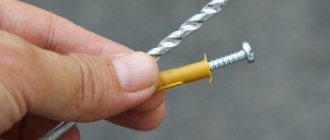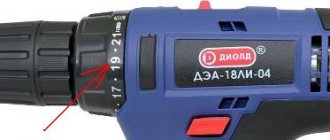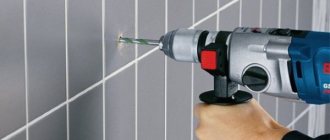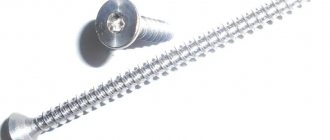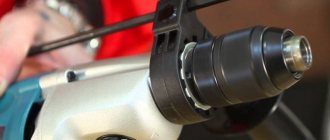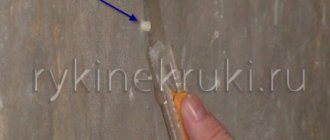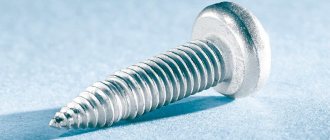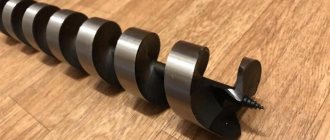From the author: hello, friends! To carry out repair and construction work, it is often necessary to drill into concrete and brick walls. Drills for metal surfaces are not suitable; they quickly begin to become dull and differ in the cutting part, quality and other features. Therefore, you need to know which drill bits for concrete are best, because there are quite a large number of their manufacturers.
Features of concrete drills
If a special alloy is soldered onto the cutting part of the tool, the drill turns from a regular one into a pobedite one. This is the name given to ultra-strong steel, consisting of 90% tungsten carbide and 10% cobalt. Pobedit's strength parameters are not inferior to diamonds, but are much cheaper to obtain.
Differences between drill tips:
- Wood needs a very sharp part that will stick into the surface.
- For metal, a pointed part is not necessary. The main part is the cutting cone-shaped part.
- The concrete tool generally has a fairly blunt tip. And all the work is done by pobedite surfacing.
Drills with reinforced tips are available in two types. And the only difference between them is in the shanks. For electric drills, the cylindrical end of the tool is made solid. Hammer drills have grooves on the shank.
The ends of the cutting tools for hammer drills are divided into two types, which have their own markings. There are drills designated SDS-max, where the recesses act as a convenient lock. The tool is fixed in the chuck by simply snapping it into place.
Differences between drill tips Source kwitka.com.ua
The SDS-plus shank has a slight thickening at the end. It helps the drill during the percussive movements of the hammer drill. This makes it easier for the tool to bite into durable concrete. Therefore, all professionals choose drills with this marking.
A concrete drill has another name. People call him Boer. And the reason lies in the size of the instrument and its shape. Typically, most drill bits are long enough to allow you to drill right through the wall.
And according to their shape, drills are divided into three types:
- Screws allow you to go much deeper.
- Spiral-shaped holes can be made with large diameters.
- Gentle ones are convenient when you need to get small and shallow passages.
When you need to make holes in walls for communications, use core-type drill attachments. They allow you to form holes up to 12 cm in diameter. Core drills for concrete drills are made in the form of a tube, which is fixed on a solid steel rod. The latter is made as a centering drill.
The working part of the crown is made in the form of teeth. They consist either of pobedite or diamond dust is applied to the metal. The latter option, although more expensive, is preferable. Because working with such a tool is much more convenient.
Diamond bit for concrete Source rgbk.ru
See also: Catalog of companies that specialize in the reconstruction and rebuilding of houses
Drilling Tips
There are a few simple rules to follow when drilling into concrete. Due to this, the work is performed more efficiently, and the service life of the product increases:
- When you first experience drilling concrete with a drill, you need to prepare several types of drills, you can even reserve them for metal. This is due to the fact that each type has its own purpose - for example, some are suitable for brick, while others are suitable for concrete and ceramics. When creating holes in the wall, there is a possibility that metal reinforcement will appear along the way, in which case the drill is changed and work continues,
- Some people specifically sharpen a concrete drill bit, so they can drill into metal during the job. This decision is wrong, since for the versatility of the product you will need to know many sharpening rules and have a lot of experience,
- It is forbidden to work without breaks; if the drill overheats, it may be damaged. It is recommended to drill for 15 seconds and then leave the drill to cool down. Do not use water or other mixtures for rapid cooling,
- Concrete always contains solid fractions in the form of stones, which can stop the drill during operation. It is easy to crush such inclusions with a chipper, and then continue to create a hole,
- if a hole needs to be made in a concrete wall, which is a load-bearing wall, or in ceilings, then it is better to use a hammer drill. Thanks to it, work is performed more efficiently and quickly,
- It is necessary to drill ceramics on walls or floors without the impact mode of the drill, otherwise the materials will be destroyed. Ceramic surfaces should only be worked with concrete drills,
- Cheap concrete drills are made from low-quality alloy, so they are not hard and need to be sharpened from time to time. To do this, you can use an angle grinder and a diamond disc,
- While drilling, it is not recommended to put pressure on the drill; this causes loss of balance, and drilling becomes more difficult. In addition, there is a possibility of the drill breaking, it simply bursts,
- To make holes for plastic dowels, it is recommended to make the depth a little larger. Dust and other dirt will not allow you to place the element correctly, a reserve is simply necessary,
- You need to start drilling concrete with low drill speeds so that the drill does not jump and the hole is smooth. After reaching a certain depth, the speed increases or the tool switches to impact mode,
- If the drill is used very often and for a long time, then you need to replace the chuck. Over the years, the fixation weakens, so the quality of work decreases, there is a risk of injury,
- When drilling, experts recommend soaking the drill in cold water, but not cooling it using this method. This rule protects the product from damage,
- To maintain cleanliness while working, it is recommended to put a plastic cup on the drill. This protects against flying concrete dust,
- Do not hold or hold the chuck with your hands while the drill is operating. You can only hold on to the body,
- When using gloves and protective clothing, it is important to use the correct size to avoid getting caught in the cartridge. Additionally, it is recommended to wear glasses to protect your eyes from dust.
When working according to the rules and using these tips, drilling concrete will be a simple and safe task, and the drills will last a long time.
Drilling technology
Let's figure out how to drill a hole in a brick wall. After all, in addition to the working attachment, the tool itself is also important. It will depend on how much energy is spent on work. And the latter can be done in three ways.
Manual drilling
The method is quite archaic. But if you don’t have a power tool at hand, and the work is slow, you’ll have to work hard. You will need a bolt and a heavy hammer. The punch is applied to the wall strictly perpendicularly, and they begin to hit its head hard.
A bolt is a piece of pipe of different diameters. The back side is thickened, but retains a through hole. On the working part, sharp teeth are made that bite into the concrete surface. Every three blows the tool rotates slightly in the hole.
Concrete or brick chips are periodically removed from the pipe. The hole is selected until it reaches the specified depth. For small diameter passages there are special punches. They are a steel rod of varying thickness with pobedit soldering on the working part.
Manual bolt for concrete Source prom.st
Electromechanical process
The operation is performed either with a hammer drill or a hand drill. But the latter must have a shock system. Otherwise, the process will drag on indefinitely, and the drill will fail faster.
And before drilling a brick wall, you need to decide on the depth, diameter and type of hole. If you need to make a hole for communications, it is better to carry out the work in three stages.
First, a through hole of small diameter is drilled. Then it expands to half, on one side. And the operation is completed on the opposite part of the wall. This way you can get a neat hole, without torn edges.
Automatic process
So-called diamond drilling is carried out using expensive professional equipment. The operator must have sufficient experience and proven qualifications. The cost of the operation is quite significant, but completely justified.
The hole can be made at almost any angle and to a depth of up to 40 cm. Moreover, the entire process is silent and dust-free. The hole turns out perfectly smooth, without chips or cracks. And the operation itself takes very little time.
Diamond drilling of a wall Source adelmsk.ru
Review of manufacturers
Drills that are used for concrete are produced by both domestic and foreign companies. The cost largely depends on the country of origin. The high price of the product is justified, since all types of concrete products are characterized by a long service life and improved quality. It is very difficult to say exactly which is the best concrete drill bit for a drill. Among the leaders from foreign brands are:
- Makita - precision drills with unusual brazing. While working, it is easy to create smooth and clear holes of different sizes, but more often they are shallow,
- Bosch is the most popular company producing equipment and materials for repairs and construction. The drills have a four-spiral working surface. This ensures maximum performance and minimum friction. Often used for drilling concrete of any density and creating deep holes,
- Diager Twister is a company that is distinguished by its high reliability and high-quality product. Drills are used for both concrete, brick, and other stones. The assortment is very large, there are drills for drills, hammer drills and other tools,
- Metabo and Staver .
The companies described produce high-quality products, but they are expensive. Among domestic companies and manufacturers from the CIS and China, it is necessary to highlight:
- Bison are the most common drills from domestic manufacturers. The company offers a large assortment at an affordable price with good quality,
- Interskol,
- Anchor,
- Hurricane.
Chinese drills can be quite good and reliable, but they cost more than usual. It is worth understanding that high-quality goods cannot be cheap, since only the best raw materials and new technologies are used for their production. To make the right choice, it is recommended to watch the video:
Products with low cost may be made from a poor alloy, or made in violation of the technological process. There are many fakes that are almost no different from the original. Craftsmen claim that a fake is always darker in color, since some of the stages during casting are skipped or disrupted. To save money, it is better to buy drills in a set rather than individually.
Step by step drilling process
Let's look at how to drill a brick wall with a regular drill. But the latter must have a striking mechanism. Because without it, the tool will quickly begin to overheat. And this is extremely undesirable, since it will lead to rapid wear.
The power of the drill must be at least 600 W. And the rotation speed of the drill is above two thousand revolutions per minute. It is believed that the higher this number, the better. This is partly true. But professionals prioritize a tool that has smooth speed control.
Before drilling, you need to make sure that the process will not disrupt any communications, such as electrical wiring or water pipes. If there is no paper plan for the location of the latter, then you need to use a portable metal detector. The device is able to indicate any iron that is located no deeper than one centimeter from the surface.
Household metal detector Source arrows.ru
Detailed instructions on how to drill through a brick wall:
- Markings are applied to the surface.
- By hitting the center punch at the desired point, a depression is made, which will help fix the drill in a level position.
- The tip of the nozzle is installed in the intended location.
- Holding the drill strictly straight, turn on low speeds to start working.
- Smoothly pressing on the tool, gradually increase the speed, gradually bringing it to maximum.
- The process is periodically interrupted to cool the cutting part of the drill.
- The operation is carried out either until the tip of the nozzle exits the other side of the wall, or until the desired depth of the hole is reached.
Throughout the process, it is necessary to control the position of the drill. Its displacement from the perpendicular can lead to breakage of the drill. And if it is necessary to make a through hole, then a tool of sufficient length is selected.
How to drill concrete with an impact drill
Home › Tools
Article rating Loading... The best products from AliExpress HERE ⬇
Each of us has repeatedly faced the need to mount various objects on the walls that add variety to the interior, create comfort, or simply remind us of the pleasant moments of life. Most often you have to attach lamps and sconces, paintings and photographs, mirrors and shelves to a concrete surface, install an air conditioner, or a TV.
If in the case of a small painting or photograph you can get by by driving a nail into the wall, then when the question is about more massive and heavy objects, the question of drilling holes arises.
To avoid misunderstandings when working with concrete, for example, drill breakage or dullness, it is worth properly preparing the partition, choosing a high-quality tool and selecting the correct drill.
Choosing a tool and working with it
When choosing a tool to drill a hole, you should understand that your work depends on it. A good drill accurately drills into a concrete wall or other required material, simplifying the drilling process, while a bad one will require a lot of time, may not cope with the task, or will complicate it. What you need to pay attention to when choosing a drill:
- Is it possible to change the drilling speed? – this point is important, since correction of the speed mode will ensure accurate operation of the drill, helping it not to damage the surface.
- Is it possible to hammer drill and adjust the depth? – impact drilling can be used on problem areas, softening them.
- Is it possible to hold the drill with both hands? – a drill is not a light tool and therefore preference should be given to models that are equipped with handles.
- Is the tool's power sufficient for your job?
Having decided on a drill, before starting work you need to get the hang of holding it. To do this, you should take the drill in one hand, like a pistol, and place the other hand on the handle of the tool (if it is not intended by the design, the hand is placed near the chuck).
It is necessary to hold the drill in your hands strictly horizontally, so that the hole does not turn out distorted or at the wrong angle. Wait until the drill reaches ambient temperature before turning on the drill. Sudden temperature changes can cause condensation.
If you decide to rest while working, unplug the tool.
Surface preparation
Before you start drilling, you need to make sure that there are no wiring, pipes, or electrical cables in the selected area of the ceiling. A metal detector will help you cope with this task, as it reacts to non-ferrous metals, iron and steel.
If you ignore this condition, you may stumble upon the fittings, damage the drill, or cables/pipes that were hidden in the ceiling.
If this area satisfies all the above requirements, then a point is marked on the wall, and then a small indentation is made in it at slow speed using a drill.
It is also worth remembering that the surface of a concrete wall is looser than subsequent layers.
Drill selection
This point can rightfully be considered the main one, since the quality of work and the safety of the drill itself, as well as the accuracy of the work, depend on the correctly selected drill.
Today there is a huge variety of drills on the market: for working on wood, metal, concrete. The latter are distinguished by a triangular tip. For a concrete surface, it is best to use a carbide drill, such as a Pobedit one.
This type of drill crushes the material without tearing it, which is ideal for concrete floors.
If, when drilling a wall, the drill does not go forward when it encounters a dense area, it is recommended to use a punch. Having inserted the punch into the hole, hit it with a hammer until it begins to move forward and softens the problem area. After this you can continue drilling.
It should be noted that without a punch, a hammer drill can easily cope with this kind of difficulty, but it makes holes that exceed 13 mm in diameter. If you want to use universal drills when drilling, you need to remember that they require cooling, vibration is turned off and are only suitable for a regular drill.
A little about the structure of the drill and installation of the drill
A classic drill consists of a power cable, a button, a capacitor wire, a reverse, brushes and springs, an armature, a stator, a gearbox and a chuck, bearings, a key and mounting screws. A correctly inserted drill improves the quality of drilling and can make it safer.
The first thing you should check when starting to work with a drill is whether there is any contamination on the drill itself. A rag will be an excellent assistant in cleaning drills. If the drill is loosely secured, there is a risk that it will fly out and injure the technician. Accordingly, it is necessary to immerse the drill as much as possible into the chuck (all the way!).
Under no circumstances try to “extend” the drill by incompletely immersing it in the chuck!
It is important to ensure that the drill in the tool is secured strictly along the axis. If this rule is not followed, drilling in concrete will be performed poorly, the shape of the hole may be unpredictable, and the cause of all these misunderstandings will be the elementary effect of drill beating.
Selection of power for drills
The optimal power for working on concrete to drill a hole is considered to be at least 600 W and 2500 rpm, but this figure must be adjusted depending on the manufacturer’s recommendations so as not to damage the drill. As mentioned, the concrete "crumbs" when we drill, and this does not require too much rotation.
Errors when working with a drill
- Clothes and gloves must fit properly.
Under no circumstances should you try to hold the rotating chuck with your hand - this is what the drill body is for. Otherwise, you may injure yourself. If you use gloves, do not take them “with reserve”. Gloves that do not fit properly may also become caught in the chuck and cause injury. Overalls should not dangle - they can be rolled up or pressed with sleeves.
- You should not press as hard as you can on the turned-on drill - this will cause you to fall, as it will become more difficult for you to control your balance. In addition, you may break the drill. If a tool passes through a concrete wall, the injuries it can cause to a person can be more than serious.
Source: https://moy-instrument.ru/instrumenty/kak-sverlit-beton-udarnoj-drelyu.html
Expert recommendations
Cooling of the cutting edge of the drill must be done every 15 seconds during operation. Moreover, it is undesirable to use water to speed up the process. This can lead to damage to the metal structure and damage to the drill. It is better to be patient and let the instrument cool naturally.
The passage of super-hard sections should be done in stages. When drilling, you may encounter burnt bricks or very strong stones in concrete. The rock is destroyed manually with a punch. Then turn on the drill at the lowest speed and slowly go through the difficult section, alternating manual and mechanical action.
When working with ceramic coating, be sure to turn off the impact mechanism. Knocking on such material will inevitably lead to cracking. Therefore, the passage is made at low speeds, using only smooth pressure on the tool.
Large diameter holes are also made in stages. For example, to get an even twelve-millimeter hole, you need to start with a drill with a diameter of 6 mm. Once the specified depth is reached, it is changed to a ten-millimeter tool. And the finishing pass is already made with a nozzle with a diameter of 12 mm.
How to drill concrete with a drill?
Concrete walls are the basis of many high- and low-rise buildings. Every resident sooner or later has to hang something or attach something to the wall.
A concrete drill is useful for attaching sconces, lamps, paintings, equipment, appliances, mirrors, etc. When using a conventional drill, it overheats, smoke appears, and after a few holes you have to change the attachment.
Proper drilling will help complete the procedure quickly, and the tool will last for many cycles of use.
When choosing a method for drilling concrete, you should choose the right tool. A high-quality drill with an attachment will drill through a wall quickly and accurately. Not every tool is equally well suited for this purpose. A low-quality drill for concrete will require a lot of time, and may not cope with the task at all.
A high-quality drill with an attachment will drill through a wall quickly and accurately
When choosing a tool, pay attention to:
- presence of a rotation speed regulator. It is important to be able to adjust the speed for accurate drilling. Working exclusively at maximum speed will lead to drilling a large hole and damaging the surface;
- ability to set the hammer drill mode. Useful for punching layers of higher density;
- drill installation depth adjustment;
- An auxiliary handle is included. A professional and powerful drill is a heavy power tool; it is better to have a built-in handle for working with two hands;
- satisfactory power indicators to make it convenient to drill concrete, brick and other materials, because a drill is a universal tool.
Selecting a tool and working with a drill are important procedures, otherwise the wear of materials increases and the wall collapses. After selecting the best drilling machine option, it is important to decide which drill to use to drill a concrete wall. All stores offer nozzles with pobedit tips for stone; they are optimal for concrete.
Before starting work, it is better to get used to using the selected tool. It should be comfortable to use with one hand or two. One hand is placed on the handle, and the other is on the removable handle or on the side of the body.
Choosing a tool and working with a drill are important procedures
It is important to always keep the drill strictly at right angles to the surface to prevent distortions and destruction of the coating.
Any electrical type device is vulnerable to temperature changes; it is recommended to wait until it warms up or cools down to room temperature before turning it on. With sudden changes there is a risk of condensation. If there is no need for drilling temporarily, it is better to unplug the power tool.
Surface preparation
When you need to drill a hole, you should first make sure that there is no wiring, built-in pipes or cables in the selected location. An easy way to detect such elements is to use a metal detector.
There is almost always reinforcement in the wall; it is better to install a metal detector on non-ferrous metals (search for wiring) and then on steel.
If you ignore the condition, there is a risk of bumping into the reinforcement, and the Victory drill will be hopelessly destroyed.
Initially, a point is marked on the wall. To prevent the tool from slipping, make a recess with any durable metal object or drill at low speeds. After careful preparation, the concrete drill easily enters the wall. It is worth considering that a lining is applied on top of the cement - it is softer than the wall itself, which means that initially the drill goes easily, then it rests on a durable material.
Preparing the surface for work
Drill selection
The type of material and holes determines which drill to use to drill a concrete wall. The correct choice will increase the quality, accuracy of the result and the integrity of the nozzle.
The stores offer special drills for various types of materials: wood, concrete, metal. The features of drills for concrete come down to the triangular shape of the tip and the application of a carbide composition to the tip.
A conventional drill with a Pobedit drill bit can be used to crush concrete without tearing the material.
If the process stalls at the stage of drilling concrete, holes are drilled with a hammer drill or the impact mode is turned on. The only drawback of the hammer drill is the large holes, diameter 13 mm. Dense areas can be easily overcome with a mechanical punch and hammer. The area should be punched until the material softens. Then continue drilling the hole.
To drill several holes on concrete, special soldering tips are used on the nozzle:
- pobedite tip;
- universal drills, but they should be cooled regularly;
- Diamond drills for concrete are a relatively expensive material, but durable.
While drilling, make sure that there is no uncharacteristic sound of contact with metal. If you hit the reinforcement in the wall, it is important to complete the procedure while the nozzle is still sharp.
Choosing a drill bit for a drill
Correctly drilling concrete with reinforcement can be done in 3 stages:
- Reach the metal layer with a pobedite tip.
- Install a drill for metal - the reinforcement is soft and should be drilled out easily.
- Continue working with the concrete drill.
Standard drill includes:
- cable from the network;
- power button;
- capacitor wires;
- reverse system;
- brushes with springs;
- anchor;
- stator;
- gearbox with chuck;
- bearings;
- keys;
- screws.
Impact drill device
When the drill is installed correctly, the quality and safety of the work increases. If you do not tighten the bit too much, there is a risk of the drill flying out and causing injury. It is recommended to immerse the nozzle all the way and clamp it with a special key.
Under no circumstances should you attempt to increase the length of the rod by partially inserting it into the chuck.
Before drilling into concrete, it is recommended to check that the drill is mounted in the center along the axis. If the slightest displacement occurs, the hole will be too wide, and there is a risk of breaking the rod or flying out of the chuck.
Before starting work, you should check for contamination on the drill. It is better to use rags to clean drills. The easiest way to drill through concrete is to press firmly on the handle in one go.
When drilling concrete, it is best to use a device with a power of 600 W and 2500 rpm. To more accurately select the rotation speed, you should familiarize yourself with the recommendations of the drill manufacturer. To drill concrete, the crumbling method is used, which does not require high speeds.
Impact drill Bosch PSB 650 RE
Errors when working with a drill
Source: https://pobetony.expert/tekhnika-i-materialy/kak-sverlit-beton-drelyu
Briefly about the main thing
To drill concrete, you must use a special drill. It has pobedite surfacing at the end. This helps with tough material. You can use a regular electric drill, but it must have an impact mechanism. Ideally, a hammer drill is used.
When drilling, it is necessary to control the position of the tool. Deviation from the perpendicular will lead to breakage of the drill. The latter can also fail faster if overheated. Therefore, the nozzle must be periodically cooled during operation.
Ratings 0
Concrete drill bit for drill and hammer drill differences
To process concrete, you can use both a hammer drill and an impact drill. These two instruments differ not only in design, but also in purpose. An impact drill is designed for drilling into metal and wood, but can also be used for working on concrete. You can only work with a drill on concrete for a short time, otherwise the mechanism of the tool will quickly wear out and become unusable.
The hammer drill is designed for processing concrete, but can also be used for working with metal and wood, but only in short-term modes. The attachments for these tools differ in the design of their shanks. For a drill, the shank has a cylindrical design, and for a hammer drill it has a special shank with SDS type grooves. It is impossible to confuse the attachments, as well as to use them on instruments for which they are not intended. However, one can argue with this, since thanks to modern adapters, a drill bit for concrete from a drill can be installed on a hammer drill.
What tool is needed to do the work?
So, we have figured out the factors influencing the resource, now let's figure out how many drills we will need to make 10,000 holes in 20 mm thick granite.
Not all granites are drilled the same way; they may differ in hardness, abrasiveness and viscosity, therefore the life of a diamond drill may differ for different granites.
Micro-impacts also affect the life of the drill - when the drill just enters the surface of the material. Therefore, use template suction cups while working. If such a template is not at hand, you can make it from improvised materials. For example, you can use the same material for a template, having previously drilled a hole in it, and you can secure such a template using clamps, placing a piece of wood between the jaws so as not to damage the polished surface of the granite.
For the operation of sintered diamond drills, an abundant supply of water is required; if there is no water or there is not enough water, the cutting part of the drill begins to overheat and, as a result, collapse. Often they bring us drills, which on average should go through about 80-100 holes, and they say that the drill went through only 10 holes, and in 90% of cases, it turns out that they drilled without water.

